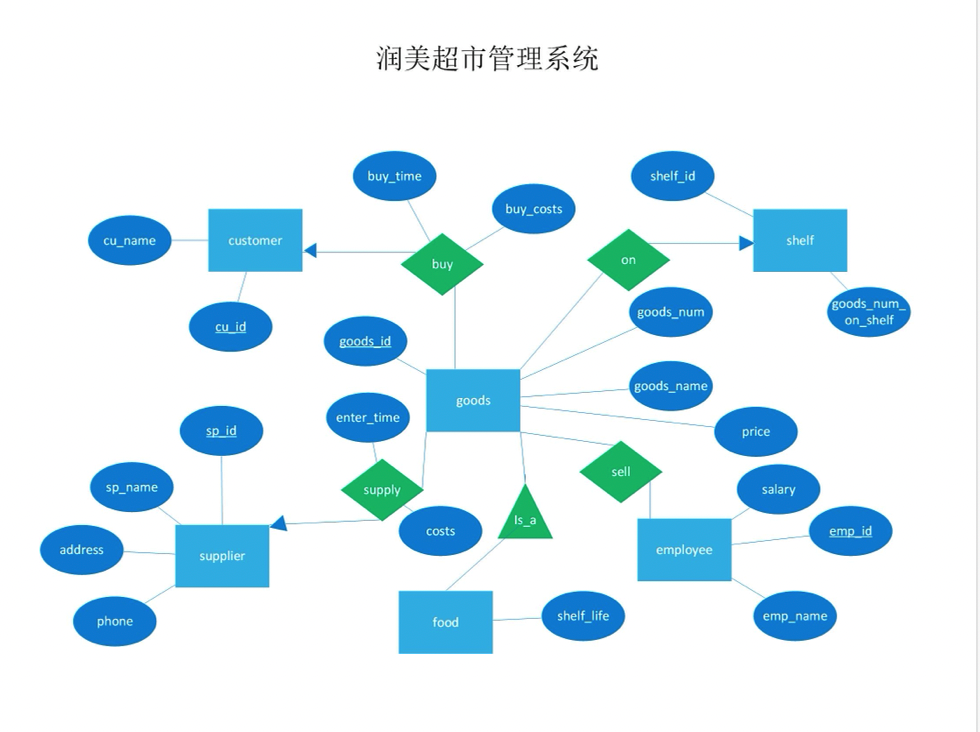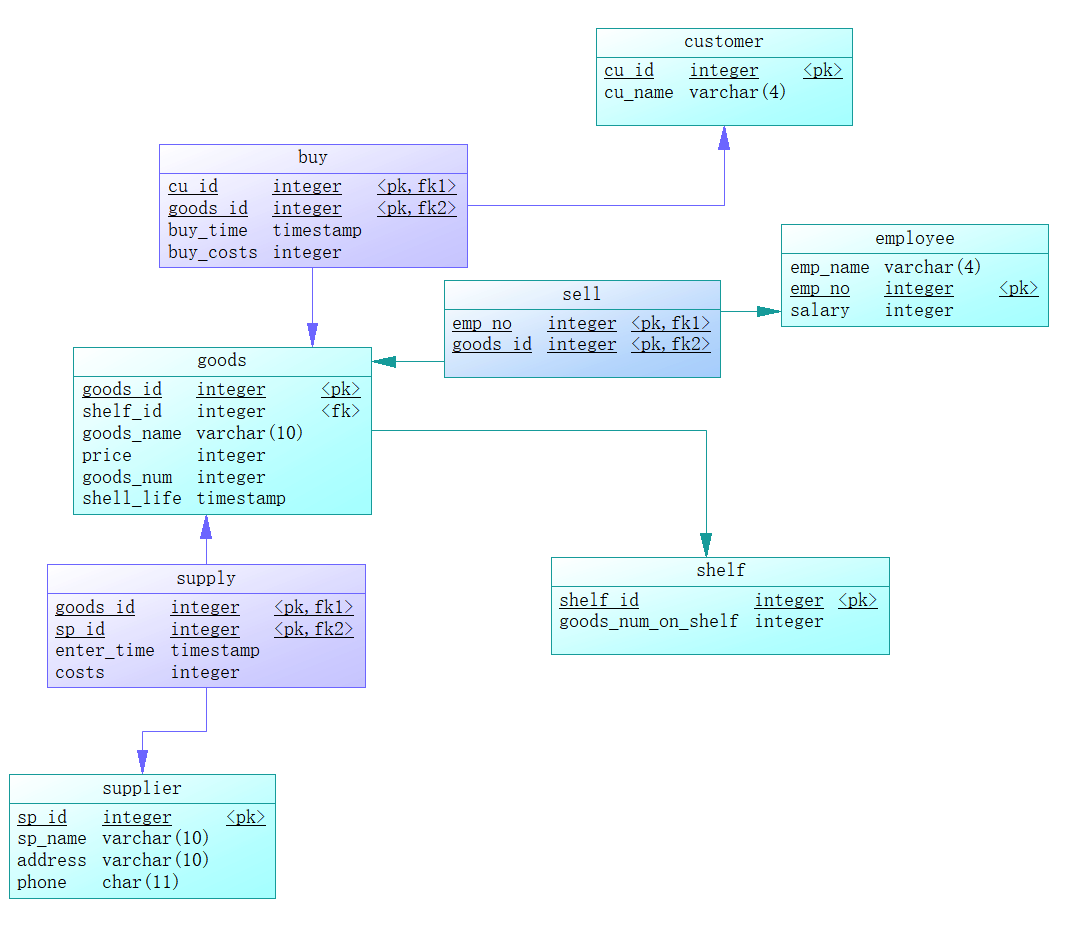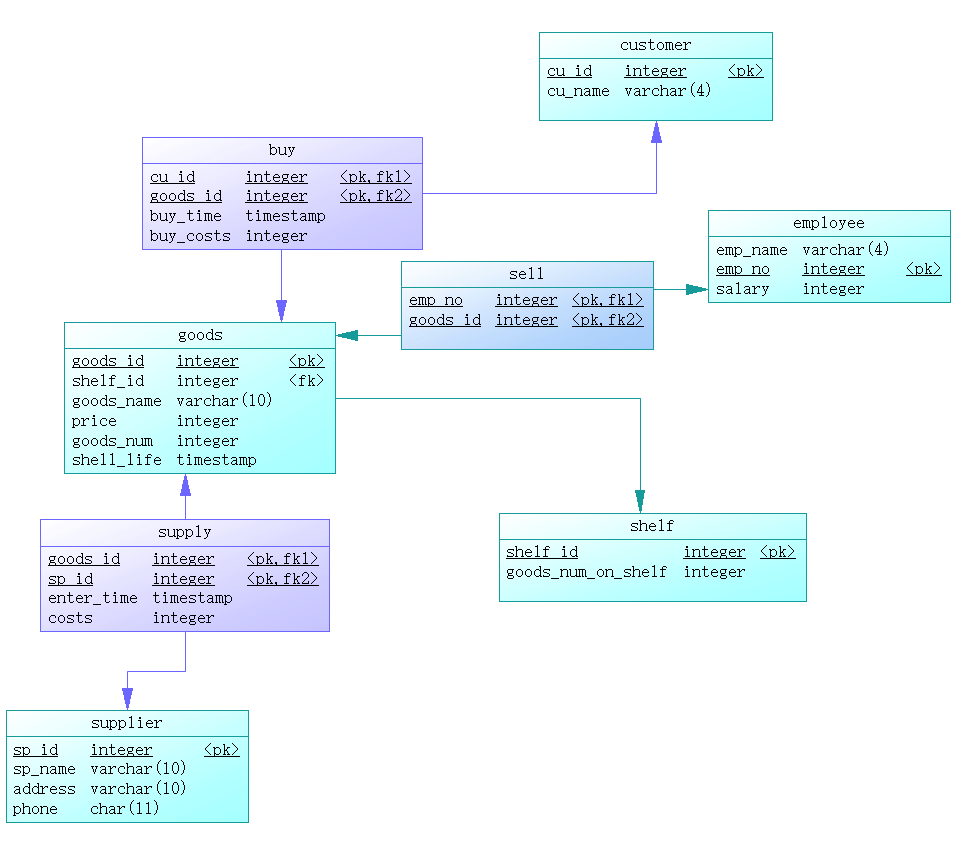数据库系统期末工程作业设计
期末工程作业
本文暂只提供相关设计思路,不提供最终实现代码。实现方面前端flask或swing上手较为快速,也可尝试其他框架。后端使用mysql数据库,关于连接数据库方式网上很容易搜到,不再赘述。
1. 需求描述
疫情期间,学校的润美超市(虚构)需要对商品物资做更详细的管理。为防止供应链出现问题,对商品的供货商需要进行详细的记录,并对顾客的购买记录进行管理。当然,也需要对商品本身和超市内工作人员进行常规的管理。作为典型的数据库应用场景,引入合适的数据管理系统能够更好的落实疫情防控要求,并让超市具有更好的营业效果。
1.商品根据名称和供应商整理,通过编号标识,记录其价格。同时对于食品还需记录其保质期,以免过期未处理。
2.进货数据需要包含商品编号、进货价,进货时间等。
3.超市内有若干工作人员,需要对其个人信息和销售商品所得薪水进行储存。
4.需要对顾客信息进行储存。并对应购买时间和商品,形成销售日志。
2.1 概念模型ER图

2.2 关系模式转换
注:1.普通商品采用使用空值的方式,food与goods共用一张表
2.斜体代表外键
goods(goods_id, shelf_id, goods_name, supplier_id, price, good_num)
//food(goods_id, shelf_id, goods_name, supplier_id, price, good_num, shelf_life)
supplier(sp_id, sp_name, phone, address)
supply(sp_id, goods_id, enter_time, costs)
employee(emp_no, emp_name, salary)
customer(cu_id, cu_name)
buy(cu_id, goods_id, buy_time, buy_costs)
shelf(shelf_id, goods_num_on_shelf)
sell (emp_no, goods_id)
2.3 SQL创建关系模式
create table goods
(
goods_id integer not null,
shelf_id integer not null,
goods_name varchar(10) not null,
price integer not null,
goods_num integer not null,
shell_life timestamp null,
constraint PK_GOODS primary key (goods_id)
);
alter table goods
add constraint FK_GOODS_ON_SHELF foreign key (shelf_id)
references shelf (shelf_id)
on update restrict
on delete restrict;
create table supplier
(
sp_id integer not null,
sp_name varchar(10) not null,
address varchar(10) not null,
phone char(11) not null,
constraint PK_SUPPLIER primary key (sp_id)
);
create table supply
(
goods_id integer not null,
sp_id integer not null,
enter_time timestamp not null,
costs integer not null,
constraint PK_SUPPLY primary key clustered (goods_id, sp_id)
);
create table customer
(
cu_id integer not null,
cu_name varchar(4) not null,
constraint PK_CUSTOMER primary key (cu_id)
);
create table shelf
(
shelf_id integer not null,
goods_num_on_shelf integer not null,
constraint PK_SHELF primary key (shelf_id)
);
create table employee
(
emp_name varchar(4) not null,
emp_no integer not null,
salary integer null,
constraint PK_EMPLOYEE primary key (emp_no)
);
create table buy
(
cu_id integer not null,
goods_id integer not null,
buy_time timestamp null,
buy_costs integer null,
constraint PK_BUY primary key clustered (cu_id, goods_id)
);
alter table buy
add constraint FK_BUY_BUY_CUSTOMER foreign key (cu_id)
references customer (cu_id)
on update restrict
on delete restrict;
create table sell
(
emp_no integer not null,
goods_id integer not null,
constraint PK_SELL primary key clustered (emp_no, goods_id)
);
alter table sell
add constraint FK_SELL_SELL_EMPLOYEE foreign key (emp_no)
references employee (emp_no)
on update restrict
on delete restrict;
alter table sell
add constraint FK_SELL_SELL2_GOODS foreign key (goods_id)
references goods (goods_id)
on update restrict
on delete restrict;2.4 查询语句样例
1.单表查询
查询单价为10元的商品名称
select goods_name
from goods
where price=102.多表连接查询
查询每个厂商生产商品的平均价格
select sp_id,avg(price)
from supply natural join goods
group by sp_id3.4多表嵌套查询和exist查询
查询只有一种商品的货架,返回这种商品的名称和货架id
select goods_name,shelf_id
from goods,shelf
where goods.shelf_id=shelf.shelf_id and goods.goods_num=shelf.goods_num_on_shelf也可以只在goods表中查
select goods_name
from goods g1
where not exists (select
*
from goods
where shelf.id=e1.shelf.id and
goods_name<>e1.goods_name);5.聚合查询
有10种以上商品的货架,以及拥有的商品种类数
select shelf_id,count(*)
from goods
group by shef_id
having count(*)>10;3.1 PowerDesigner 绘制ER图

3.2 转为关系模型

3.3 生成SQL语句
/*==============================================================*/
/* DBMS name: Sybase SQL Anywhere 12 */
/* Created on: 2022/4/15 22:28:49 */
/*==============================================================*/
if exists(select 1 from sys.sysforeignkey where role='FK_BUY_BUY_CUSTOMER') then
alter table buy
delete foreign key FK_BUY_BUY_CUSTOMER
end if;
if exists(select 1 from sys.sysforeignkey where role='FK_BUY_BUY2_GOODS') then
alter table buy
delete foreign key FK_BUY_BUY2_GOODS
end if;
if exists(select 1 from sys.sysforeignkey where role='FK_GOODS_ON_SHELF') then
alter table goods
delete foreign key FK_GOODS_ON_SHELF
end if;
if exists(select 1 from sys.sysforeignkey where role='FK_SELL_SELL_EMPLOYEE') then
alter table sell
delete foreign key FK_SELL_SELL_EMPLOYEE
end if;
if exists(select 1 from sys.sysforeignkey where role='FK_SELL_SELL2_GOODS') then
alter table sell
delete foreign key FK_SELL_SELL2_GOODS
end if;
if exists(select 1 from sys.sysforeignkey where role='FK_SUPPLY_SUPPLY_GOODS') then
alter table supply
delete foreign key FK_SUPPLY_SUPPLY_GOODS
end if;
if exists(select 1 from sys.sysforeignkey where role='FK_SUPPLY_SUPPLY2_SUPPLIER') then
alter table supply
delete foreign key FK_SUPPLY_SUPPLY2_SUPPLIER
end if;
drop index if exists buy.buy2_FK;
drop index if exists buy.buy_FK;
drop index if exists buy.buy_PK;
drop table if exists buy;
drop index if exists customer.customer_PK;
drop table if exists customer;
drop index if exists employee.emplyer_PK;
drop table if exists employee;
drop index if exists goods.on_FK;
drop index if exists goods.goods_PK;
drop table if exists goods;
drop index if exists sell.sell2_FK;
drop index if exists sell.sell_FK;
drop index if exists sell.sell_PK;
drop table if exists sell;
drop index if exists shelf.shelf_PK;
drop table if exists shelf;
drop index if exists supplier.supplier_PK;
drop table if exists supplier;
drop index if exists supply.supply2_FK;
drop index if exists supply.supply_FK;
drop index if exists supply.supply_PK;
drop table if exists supply;
/*==============================================================*/
/* Table: buy */
/*==============================================================*/
create table buy
(
cu_id integer not null,
goods_id integer not null,
buy_time timestamp null,
buy_costs integer null,
constraint PK_BUY primary key clustered (cu_id, goods_id)
);
/*==============================================================*/
/* Index: buy_PK */
/*==============================================================*/
create unique clustered index buy_PK on buy (
cu_id ASC,
goods_id ASC
);
/*==============================================================*/
/* Index: buy_FK */
/*==============================================================*/
create index buy_FK on buy (
cu_id ASC
);
/*==============================================================*/
/* Index: buy2_FK */
/*==============================================================*/
create index buy2_FK on buy (
goods_id ASC
);
/*==============================================================*/
/* Table: customer */
/*==============================================================*/
create table customer
(
cu_id integer not null,
cu_name varchar(4) not null,
constraint PK_CUSTOMER primary key (cu_id)
);
/*==============================================================*/
/* Index: customer_PK */
/*==============================================================*/
create unique index customer_PK on customer (
cu_id ASC
);
/*==============================================================*/
/* Table: employee */
/*==============================================================*/
create table employee
(
emp_name varchar(4) not null,
emp_no integer not null,
salary integer null,
constraint PK_EMPLOYEE primary key (emp_no)
);
/*==============================================================*/
/* Index: emplyer_PK */
/*==============================================================*/
create unique index emplyer_PK on employee (
emp_no ASC
);
/*==============================================================*/
/* Table: goods */
/*==============================================================*/
create table goods
(
goods_id integer not null,
shelf_id integer not null,
goods_name varchar(10) not null,
price integer not null,
goods_num integer not null,
shell_life timestamp null,
constraint PK_GOODS primary key (goods_id)
);
/*==============================================================*/
/* Index: goods_PK */
/*==============================================================*/
create unique index goods_PK on goods (
goods_id ASC
);
/*==============================================================*/
/* Index: on_FK */
/*==============================================================*/
create index on_FK on goods (
shelf_id ASC
);
/*==============================================================*/
/* Table: sell */
/*==============================================================*/
create table sell
(
emp_no integer not null,
goods_id integer not null,
constraint PK_SELL primary key clustered (emp_no, goods_id)
);
/*==============================================================*/
/* Index: sell_PK */
/*==============================================================*/
create unique clustered index sell_PK on sell (
emp_no ASC,
goods_id ASC
);
/*==============================================================*/
/* Index: sell_FK */
/*==============================================================*/
create index sell_FK on sell (
emp_no ASC
);
/*==============================================================*/
/* Index: sell2_FK */
/*==============================================================*/
create index sell2_FK on sell (
goods_id ASC
);
/*==============================================================*/
/* Table: shelf */
/*==============================================================*/
create table shelf
(
shelf_id integer not null,
goods_num_on_shelf integer not null,
constraint PK_SHELF primary key (shelf_id)
);
/*==============================================================*/
/* Index: shelf_PK */
/*==============================================================*/
create unique index shelf_PK on shelf (
shelf_id ASC
);
/*==============================================================*/
/* Table: supplier */
/*==============================================================*/
create table supplier
(
sp_id integer not null,
sp_name varchar(10) not null,
address varchar(10) not null,
phone char(11) not null,
constraint PK_SUPPLIER primary key (sp_id)
);
/*==============================================================*/
/* Index: supplier_PK */
/*==============================================================*/
create unique index supplier_PK on supplier (
sp_id ASC
);
/*==============================================================*/
/* Table: supply */
/*==============================================================*/
create table supply
(
goods_id integer not null,
sp_id integer not null,
enter_time timestamp not null,
costs integer not null,
constraint PK_SUPPLY primary key clustered (goods_id, sp_id)
);
/*==============================================================*/
/* Index: supply_PK */
/*==============================================================*/
create unique clustered index supply_PK on supply (
goods_id ASC,
sp_id ASC
);
/*==============================================================*/
/* Index: supply_FK */
/*==============================================================*/
create index supply_FK on supply (
goods_id ASC
);
/*==============================================================*/
/* Index: supply2_FK */
/*==============================================================*/
create index supply2_FK on supply (
sp_id ASC
);
alter table buy
add constraint FK_BUY_BUY_CUSTOMER foreign key (cu_id)
references customer (cu_id)
on update restrict
on delete restrict;
alter table buy
add constraint FK_BUY_BUY2_GOODS foreign key (goods_id)
references goods (goods_id)
on update restrict
on delete restrict;
alter table goods
add constraint FK_GOODS_ON_SHELF foreign key (shelf_id)
references shelf (shelf_id)
on update restrict
on delete restrict;
alter table sell
add constraint FK_SELL_SELL_EMPLOYEE foreign key (emp_no)
references employee (emp_no)
on update restrict
on delete restrict;
alter table sell
add constraint FK_SELL_SELL2_GOODS foreign key (goods_id)
references goods (goods_id)
on update restrict
on delete restrict;
alter table supply
add constraint FK_SUPPLY_SUPPLY_GOODS foreign key (goods_id)
references goods (goods_id)
on update restrict
on delete restrict;
alter table supply
add constraint FK_SUPPLY_SUPPLY2_SUPPLIER foreign key (sp_id)
references supplier (sp_id)
on update restrict
on delete restrict;4.1 分析差异
有差异。PowerDesigner会事先判断外键约束、索引以及表本身是否存在,若存在会删除。同时也会对表建立索引。但是基本逻辑是一致的,在总体的设计上不会造成影响。
4.2 语句特点
从4.1的分析可以看出,PowerDesigner生成的语句更严谨。当然,语句顺序比如外键约束声明的位置也有不同。这些附加语句的作用是防止特殊情况的发生导致无法正常建立表。